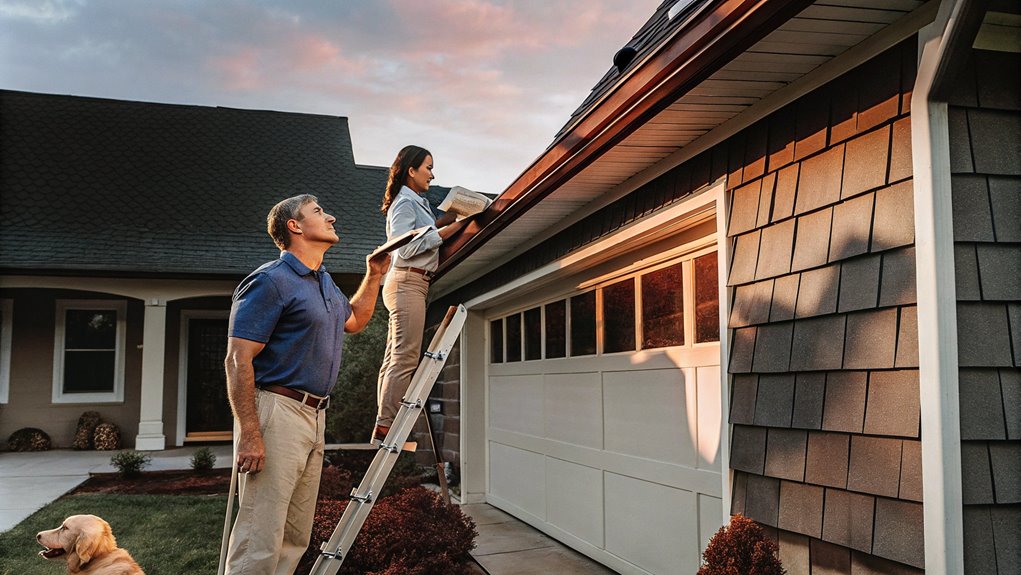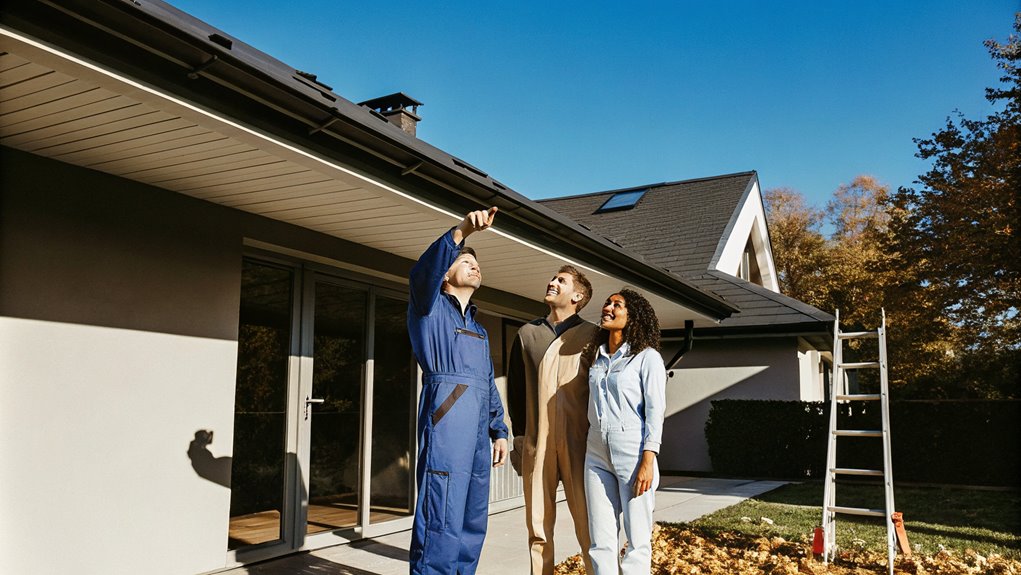Is your roof feeling under the weather? Let's talk about fixing it up or getting a new one.
If your roof is young – less than 15 years old – and has only small problems, you can fix it. These fixes cost about $1,000 to $3,000.
But if your roof is old – more than 15 years – and has lots of problems, you might need a new one. A new roof costs $8,000 to $20,000. This might seem like a lot, but it can save you money over time.
Old roofs lose heat fast. After 10 years, they only keep half the heat they used to. Fixing an old roof over and over can cost more than getting a new one.
Look for signs that your roof needs help:
- Wet spots on your ceiling
- Parts of the roof that sink down
- Missing roof tiles
Taking care of roof problems early will save you from big, sudden costs later.
Ready to start building equity in your own Michigan home? Get your personalized home loan quote today.
Age Matters: Your Roof's Timeline

Your Roof Gets Old Too
Just like people, roofs have a life span. Most regular black roofs last 20 to 25 years. Metal roofs can last even longer – 40 to 70 years! It helps to know when your roof was put on and to write down when you fix it.
When your roof gets to be 15 years old, you need to think hard about its future. Even if you see small leaks or broken spots, fixing them mightn't be worth the money. Why? Because you may need a whole new roof soon anyway.
Also, check your roof's promise paper (that's the warranty). Many of these run out after 20 years. This means you'll have to pay for fixes yourself.
The weather where you live can also make your roof get old faster, so keep that in mind too.
Michigan residents, unlock the door to your new home. Request your home loan quote from Treeside Financial today.
Signs of Serious Roof Damage
Your roof keeps you safe and dry, just like a big umbrella.
Watch out for these signs that tell you your roof needs help:
When you look up, do you see:
You might be closer to buying your home than you think
Take our 2-minute home buyer readiness quiz to see how prepared you really are – no credit check required.

- Parts of the roof sinking down
- Missing roof tiles
- Holes where sunlight peeks through
- Brown spots on your ceiling
- Little black bits in your gutters
Walk on your roof with care.
Feel for soft spots that sink under your feet. These soft spots mean your roof is getting weak.
Look at your roof after it rains.
Dark spots mean water is getting inside. Check your roof tiles too. If many are bent or broken, your roof needs fixing.
Call a roof expert right away if you see these problems.
A broken roof gets worse fast and costs more to fix if you wait.
Cost Analysis: Repair Vs Replace

Think about fixing your old roof or getting a brand new one.
Fixing your roof can cost between $1,000 to $3,000. Getting a new roof costs more – from $8,000 to $20,000.
While fixing might seem cheaper now, it adds up over time. You might spend more on fixes in 3-5 years than a new roof would cost.
A new roof stays good for 15-20 years without much work. Plus, a new roof makes your home worth more and saves money on power bills.
For every $100 you spend on a new roof, you get back $60-$70 when you sell your home.
Initial Investment Breakdown
Your Roof: Fix or Replace?
When your roof needs work, you need to know how much money to save.
Let's look at what it costs to fix or get a new roof.
For a regular home, you can expect these costs:
Fixing your roof:
- Small fixes cost $400-$1,500
- This pays for patches, new shingles, and worker time
Getting a new roof:
- A full new roof costs $8,000-$20,000
- This covers taking off the old roof
- Putting on new parts
- Getting rid of old stuff
Extra costs you might have:
- Getting permits: $250-$500
- Making the roof stronger: $500-$1,500
- Adding air holes: $300-$600
The price can change based on:
- Where you live
- What roof stuff you pick
- What things cost right now
Long-Term Financial Impact
Your roof choices affect your money now and later. Simple fixes might look cheaper at first. But you may end up paying more for many small fixes over time. In just a few years, all those fixes can cost more than getting a new roof.
A new roof costs more up front. But it keeps your home safe for 20 to 30 years when you take good care of it.
New roofs help save money on your power bills too. They keep your home cooler in summer and warmer in winter.
If you sell your house, a new roof helps you get more money for it. Plus, if something goes wrong with your new roof, the maker will fix it for free.
Return on Investment Comparison
When you fix your roof, you want to get the most for your money. Let's look at what you get back when you sell your home.
A new roof costs a lot but pays off well. If you put in a new roof, you get back about $7 out of every $10 you spend. A new roof can make your home worth up to $15,000 more.
Small roof fixes cost less but don't pay back as much. You get back about $6 out of every $10 you spend. These small fixes won't make your home worth much more unless they fix damage you can see.
Medium roof fixes fall in the middle. You get back about $6.50 out of every $10 you spend. These fixes can make your home worth up to $8,000 more.
To get the best deal, look at how good your house is now.
Also check what houses sell for in your area. This will help you pick between fixing or replacing your roof.
Weather Impact on Roof Decisions
Your roof needs a checkup just like you do. You want to know if storms hurt your roof or if it's just getting old.
The best time to look at your roof is when the sky is clear. Try to check it in spring and fall.
Where you live makes a big difference too. Hot sun, rain, and cold winters can make your roof wear out faster. This helps you pick the right roof for your home.
Storm Damage Vs Age
When your roof gets hit by a storm, you need to fix it fast.
Old roofs just wear out slowly over time, so you can plan ahead for fixes.
Think about these things:
- Storm hits leave marks in spots.
- Old roofs wear down the same way all over.
- Storms rip and tear parts off.
- Old roofs curl up and lose tiny bits over time.
- Big storms make holes that leak in one place.
- Old roofs get weak all over.
Take lots of pictures of storm damage.
Your insurance might pay for storm fixes, but not for an old roof that just got worn out.
It helps to know what caused your roof damage.
This way you can fix it the right way and know if insurance will help pay for it.
Seasonal Inspection Timing
Your roof needs a check-up two times each year to stay strong. The best times are spring and fall when it's not too hot or cold outside.
In spring, look for problems from winter ice and snow. Check if any parts are loose or broken. This helps your roof stay safe when summer storms come.
In fall, get your roof ready for winter. Fix any damage from summer storms. Make sure water can flow off your roof the right way.
If big storms or hail hit your home, don't wait to check your roof. Call someone right away to stop water from getting inside and making things worse.
Climate Zone Considerations
Your roof needs different care based on where you live. Think about the weather in your area. Bad weather can hurt your roof faster than nice weather. A small fix might work in a nice climate, but you might need a new roof if you live where the weather is rough.
Here's what to think about in different places:
- If you live where it's wet, watch out for water damage. Your roof might need to be fixed sooner to stay safe.
- If you get lots of snow, check if your roof is strong enough to hold it.
- Near the ocean, salt and strong winds can make your roof wear out much faster.
The weather where you live matters a lot. It helps you pick the best way to fix your roof and save money.
Material Types and Longevity

Roofs can last a long time if you pick the right stuff to build them with. Each type of roof has its own story to tell.
Think of it like this:
- Asphalt shingles are like a trusty car – they work well but need some care every now and then. They last about 20-30 years.
- Metal roofs are tough, like a tank. They can stand tall for 40-70 years.
- Clay or concrete tiles are the kings of roofs. They can last up to 100 years!
| Roof Type | How Long It Lasts | Easy to Fix? |
|---|---|---|
| Asphalt | 20-30 years | Very Easy |
| Metal | 40-70 years | Kind of Easy |
| Tiles | 50-100 years | Hard |
You might spend more money at first on metal or tile roofs. But they last longer and need less care over time. Asphalt is the easiest to fix when it breaks, but you'll need to fix it more often than the others.
Energy Efficiency Considerations
Your roof helps keep your home warm in winter and cool in summer.
Over time, old roofs don't work as well. The soft parts inside get flat and worn out. You might see your power bills go up when this happens. Bad air flow in your attic makes this worse.
Before you fix or get a new roof, ask an expert to check how well your old one works. New roofs with better padding and air flow can save you money on power bills.
Insulation Value Vs Age
Your roof keeps your home cozy, like a warm blanket. But just like an old blanket, it gets worn out over time. This means your home won't stay as warm or cool as it used to.
As your roof gets older, it doesn't work as well to save energy. This means you might pay more to heat and cool your home. Most roofs start to lose their power to keep heat in after 15-20 years.
Here's what happens to your roof as it ages:
- It loses about half of its power to keep heat in during the first 10 years.
- If water gets in, even a tiny bit, your roof won't work as well.
- Old roof air holes can't help control heat, so your AC has to work harder.
Watch your power bills. If they go up a lot, your roof might need help.
Ventilation System Performance
Your roof needs to breathe like you do. Good air flow in your roof helps save money on power bills.
Let's see if your roof is getting enough air. Look at the vents in your roof. Make sure nothing blocks them. Check both the bottom edge vents and top vents. You want as much air going in as coming out.
Bad roof air flow causes problems. Your power bills go up. Your attic gets too hot. Ice builds up in winter. These are signs you need to fix things.
If your roof is new, you might just need to fix the vents. But if your roof is old and many vents are broken, you may need a new roof.
A new roof will give you better air flow and save you money.
Hidden Structural Problems

Your roof needs to be strong to keep you safe. Sometimes there are big problems you can't see right away. You need to check the whole roof to find them.
Look up in your attic. You might find:
- The roof wood sags down in spots
- Dark wet marks on the wood beams
- Broken or cracked wood pieces
These are signs that your roof is weak. You can't just fix little parts – you need a whole new roof. The longer you wait, the worse it gets.
When you see these problems, call a roofer right away. They know how to make your home safe again.
A strong roof means a safe home for you and your family.
Insurance Coverage and Claims
Your roof is important, and when it gets hurt, your insurance can help fix it. If a big storm or tree breaks your roof, insurance will pay. But they won't help if you didn't take good care of your roof.
Take lots of pictures of the damage right away. Write down what you see. Call your insurance company fast – don't wait! They need to know soon after it happens.
When the insurance person comes to look at your roof, have a roof expert there too. This helps make sure they see all the damage. If you think the insurance person missed something, you can ask for another look.
Keep all your papers safe – the photos, letters, and what experts say about your roof.
Sometimes insurance will only want to fix part of your roof when you think you need a new one. You can ask them to change their mind. Just show them what roof experts say about the damage.
Local Climate Factors

Your roof needs extra care based on where you live.
If you get lots of big storms like hurricanes or tornados, you need a strong roof that can handle high winds.
In snowy places, the weight of snow and ice can hurt your roof.
Hot and cold weather can also make your roof grow and shrink, which can cause cracks.
Think about the weather in your area when you decide to fix or get a new roof.
Extreme Weather Impact Areas
Bad weather can really hurt your roof. When you live where storms are common, you need to think hard about fixing or replacing your roof.
Look at these spots that often get damaged:
- Corner spots where strong winds hit. These winds can be as fast as a race car and can tear up your roof.
- Places where hail hits hard, mostly on the west and south sides of your roof. Big hail can make holes in your shingles.
- Spots where water and ice build up. The weight can be as heavy as a small car.
If you see damage in many of these spots, you should get a new roof. Small fixes mightn't keep your home safe enough.
Snow and Ice Buildup
Your roof needs extra care in winter when snow and ice build up.
Snow can get very heavy – even a small amount adds up fast! Light fluffy snow isn't too bad, but wet snow can weigh a lot.
Look at how much different snow types weigh:
- Light powder snow: 3 pounds
- Packed snow: 12 pounds
- Ice: 15 pounds
- Wet snow: 21 pounds
Watch for warning signs that your roof is in trouble:
- Does the roof sag between beams?
- Do you hear creaking sounds?
- Is ice building up along the edges?
If you see these signs, call a roof expert right away.
Don't wait for spring. Ice at the edge of your roof can trap water and cause leaks in your house.
If ice keeps building up winter after winter, you may need a new roof. Old roofs often have poor air flow or not enough padding to keep heat in.
Seasonal Temperature Fluctuations
Your roof changes with the weather, just like we put on different clothes for hot and cold days. When it's cold, your roof gets smaller. When it's hot, it gets bigger. This can make cracks in your roof, like when you stretch and bend a stick too much.
Look for these signs that your roof is tired from the weather:
- Roof tiles that curl up at the edges, like a dry leaf
- New gaps you can see between parts of your roof
- Marks where metal parts of your roof meet other parts
Sometimes you can fix small spots on your roof. But if you see many bad spots, you might need a new roof.
Pick roof materials that work well with your local weather.
Professional Inspection Results
Getting your roof checked by an expert is the first step to fixing it. They will look at your roof up close and tell you what's wrong. You'll get a report that shows if your roof is safe or needs work right now.
| Roof Damage | What To Do |
|---|---|
| Small spots | Fix spots |
| Some spots | Fix parts |
| Big damage | New roof |
The expert will look at the wood under your roof. They check the metal parts and make sure air flows well. They can find wet spots and black mold you can't see from the ground. When you know what's wrong with your roof, you can make a smart choice about fixing it. This keeps your house safe and worth more money.
Multiple Layers Already Present

Your roof might've layers of old shingles on top of each other. This can make fixing your roof harder. The rules say you can only have two layers. If you already have two layers, you must take off all the old shingles before putting on new ones.
Having too many roof layers can cause big problems:
- The weight can make your roof sag or break.
- You can't see if the wood under the shingles is bad.
- Heat and water get stuck between layers, which makes your roof wear out faster.
Want to know how many layers your roof has? Look at the edges where your roof meets the walls.
Or you can ask a roof expert to check for you. Stay safe – don't add more layers than the rules allow.
Current Market Value Assessment
Your home is worth a certain amount right now. This helps you pick between fixing your roof or getting a new one.
Think of it this way – don't spend more than $20 of every $100 your home is worth on a new roof. You won't get all that money back later.
If you want to sell your home soon, your roof choice matters. A new roof can make your home worth more – you get back about $60-70 for every $100 you spend.
Simple fixes might be enough if houses in your area sell for normal prices.
Ask a local house seller to look at prices of homes like yours. See what they say about how roofs change home prices in your area.
Look at what people pay for homes with new roofs near you.
Future Home Sale Plans

When you want to sell your home, your roof matters a lot.
Think about when you plan to sell to make smart choices about fixing or getting a new roof. Home buyers look closely at roofs, and a bad one can make it hard to sell your house.
If you want to sell in 1-2 years:
Get a new roof with a warranty that carries over to the new owner. This will help you sell faster.
If you want to sell in 3-5 years:
You might only need to fix the bad spots if the rest of your roof is in good shape.
If you want to sell after 5 years:
Fix what's wrong now and save up for a new roof when you get closer to selling.
Warranty Status and Coverage
Your roof's warranty is like a promise that helps pay for fixes when things go wrong. Think of it as a safety net for your home. You need to find your warranty papers to see what it covers.
Most roofs come with two kinds of promises. The first one is from the people who made the stuff for your roof. This can last 20 to 50 years. The second is from the workers who put your roof on. Their promise usually lasts 2 to 10 years.
If your roof needs help and is still under warranty, you must follow some simple steps. Don't try to fix it yourself – this can break the promise.
Call the people who put your roof on first. They know your roof best.
Take pictures of any damage you see. Write down when you talk to people about your roof. Keep track of when you clean and check your roof. You'll need this info to get help with fixes.
Seasonal Timing for Projects

Picking the right time of year for your new roof matters a lot. Let's look at what works best.
Most roofers like to work from late spring to early fall. The good weather helps them do their best work.
In spring:
- You can save money
- Workers can start sooner
- Rain might slow things down
In summer:
- The warm sun helps the roof stick well
- Workers can move fast
- It costs more because many people want work done
In fall:
- The mild weather is perfect
- Not much rain gets in the way
- Many people want work done, so you might wait longer
Stay away from winter roof work. The cold makes the parts break easily. Ice and snow make it risky for workers. The roof parts also won't stick well in cold weather.








